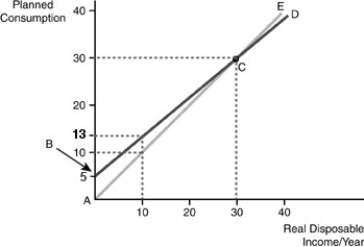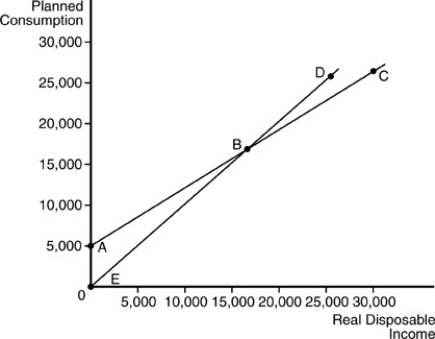A) 0.25.
B) 0.75/0.25 = 3.
C) 4.
D) 5.
Correct Answer

verified
Correct Answer
verified
Multiple Choice
If the marginal propensity to consume is unchanged and autonomous consumption expenditures increase,then
A) saving at every level of disposable income increases.
B) the break-even disposable income decreases.
C) the break-even disposable income increases.
D) saving is unaffected.
Correct Answer

verified
Correct Answer
verified
Multiple Choice
If the multiplier is 10,then the marginal propensity to consume (MPC) is
A) 0.9.
B) 0.1.
C) 1.
D) 9.
Correct Answer

verified
Correct Answer
verified
Multiple Choice
Which of the following is a flow variable?
A) Savings
B) Wealth
C) Consumption
D) Population
Correct Answer

verified
Correct Answer
verified
Multiple Choice
Which of the following does NOT occur when the economy is operating at the equilibrium level of GDP?
A) Total planned expenditures equal real GDP.
B) Real GDP tends to rise over time.
C) Planned investment equals actual investment.
D) Inventory investment equals zero.
Correct Answer

verified
Correct Answer
verified
Multiple Choice
When the equilibrium price level adjusts to an increase in autonomous investment spending,the impact of the multiplier effect resulting from that spending increase
A) will increase real GDP by an amount smaller than the multiplier effect would indicate.
B) will increase nominal GDP by an amount smaller than the multiplier effect would indicate.
C) will have no impact on the real GDP.
D) is only felt when there are changes in consumption.
Correct Answer

verified
Correct Answer
verified
Multiple Choice
The terms "saving" and "savings" differ in that
A) saving is a stock,and savings are a flow.
B) saving always exceeds savings.
C) savings are a stock,and saving is a flow.
D) savings can be negative,but saving cannot.
Correct Answer

verified
Correct Answer
verified
Multiple Choice
Autonomous consumption is the level of consumption that is
A) consistent with the average standard of living.
B) observed at the poverty line.
C) independent of real income.
D) available to someone earning the minimum wage.
Correct Answer

verified
Correct Answer
verified
Multiple Choice
Investment is
A) the purchasing of stocks and mutual funds.
B) goods bought by households.
C) spending by businesses on things which can be used to produce goods and services in the future.
D) the production of goods for immediate satisfaction.
Correct Answer

verified
Correct Answer
verified
Multiple Choice
A lower price level causes the C + I + G + X curve to shift as a result of a change in all the following EXCEPT
A) an increase in real wealth.
B) a decrease in interest rates.
C) an increase in aggregate supply.
D) an increase in foreign spending on domestic goods.
Correct Answer

verified
Correct Answer
verified
Multiple Choice
The marginal propensity to save (MPS) is
A) the rate at which real savings changes over time.
B) the percentage of real disposable income saved.
C) the difference between the amounts of real disposable income consumed and saved.
D) the percentage of an additional dollar of real disposable income that will go toward additional real savings.
Correct Answer

verified
Correct Answer
verified
Multiple Choice
Which of the following is correct?
A) 1 + MPS = MPC
B) 1 - MPC = MPS
C) 1 - MPS = MPC + 1
D) 1 - MPS = MPC - 1
Correct Answer

verified
Correct Answer
verified
Multiple Choice
Which of the following represents the relationship between disposable income (DI) ,consumption (C) ,and saving (S) ?
A) DI + C = S
B) DI = C + S
C) DI = C * S
D) DI = C - S
Correct Answer

verified
Correct Answer
verified
Multiple Choice
 -Refer to the above figure.Autonomous consumption equals
-Refer to the above figure.Autonomous consumption equals
A) 0.
B) -$5000.
C) $5000.
D) $25,000.
Correct Answer

verified
Correct Answer
verified
Multiple Choice
 -Refer to the above figure.If the MPC is unchanged and level of autonomous consumption increases,what occurs?
-Refer to the above figure.If the MPC is unchanged and level of autonomous consumption increases,what occurs?
A) Line EBD will shift up.
B) Line ABC will drop down.
C) Line ABC shifts up.
D) Line EBD rotates and becomes steeper.
Correct Answer

verified
Correct Answer
verified
Multiple Choice
A higher level of real Gross Domestic Product (GDP) will result if
A) total planned real expenditures exceed real Gross Domestic Product (GDP) .
B) aggregate supply exceeds aggregate demand.
C) aggregate demand exceeds aggregate supply.
D) leakage exceeds injections.
Correct Answer

verified
Correct Answer
verified
Multiple Choice
 -In the above table,the marginal propensity to consume when disposable income changes from $5,000 to $6,000 is
-In the above table,the marginal propensity to consume when disposable income changes from $5,000 to $6,000 is
A) 0.8.
B) 0.75.
C) 0.6.
D) 0.5.
Correct Answer

verified
Correct Answer
verified
Multiple Choice
The difference between savings and saving
A) is nonexistent.
B) is that savings occurs when consumption does not and saving is used to purchase consumption goods.
C) is that savings is a stock concept and saving is a flow concept.
D) is that savings is measured in real terms while saving is measured in nominal terms.
Correct Answer

verified
Correct Answer
verified
Multiple Choice
According to Keynes,the primary determinant of a person's saving is NOT
A) the person's level of income but the desired real income of the person.
B) the person's level of savings but the expected interest rate in the near future.
C) the interest rate but the level of savings the person has.
D) the interest rate but the level of the person's real disposable income.
Correct Answer

verified
Correct Answer
verified
Multiple Choice
Which of the following statements is true?
A) investment = disposable income + consumption
B) saving = personal income - consumption
C) saving = disposable income - consumption
D) saving = personal income + consumption
Correct Answer

verified
Correct Answer
verified
Showing 41 - 60 of 445
Related Exams